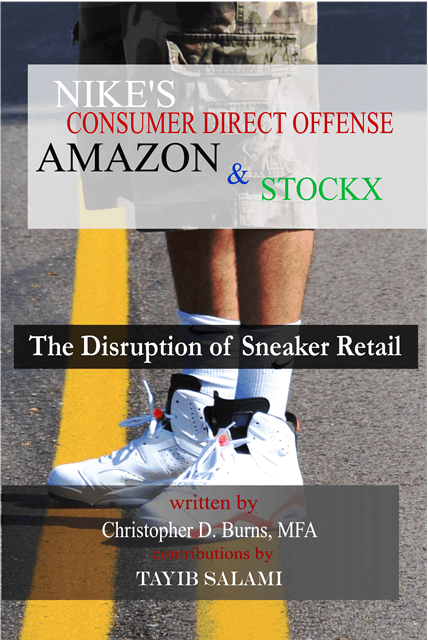![]()
My new book is now available in both Paperback and Kindle.
Here is the link for Paperback: https://amzn.to/2XafN24
Give it a look if you like ebooks: https://amzn.to/2X97PGA
In 2015 I recognized a number of smaller retail outlets losing their accounts with Nike. As the stores closed and as a number of major retail outlets began to close individual stores, I took a closer look. It was extremely important to me although sneaker sites and news outlets didn’t seem to be paying attention. I have operated an online store since 2004. I very briefly opened a brick and mortar, but I closed around the same time that the smaller retailers were encountering serious headwinds. Soon after I noticed the problems for smaller accounts, Nike announced that they were no longer placing an emphasis on Futures. That post is below:
When I closed my small brick and mortar location, at the same time a retail chain of 7 stores named Okuns in Mississippi had lost two stores. That chain eventually sold to Jimmy Jazz and I began documenting the DTC movement in a more detailed manner. What I discovered was that Nike was moving quickly towards pulling their customers to their doors (Nike Clearance Stores, Nike Factory Stores, Nike.com).
As an online sneaker shop that operated through Amazon I realized that third party sellers were in jeopardy. I noticed that the more aggressive Nike became in reaching their customer the market for flipping and reselling shoes decreased. Amazon had joined into the sneaker resell market by initially bringing in sellers from eBay, but around 2015 at the same moment that Nike became machine like in DTC, Amazon launched a serious strategy with their Brand Registry for athletic footwear.
Nike’s CDO by 2018 had a name and a destination: To control an 80/20 share of the distribution of their footwear in North America. An extremely bold number and unlike anything retail has ever seen. The Swoosh has been able to implement the strategy by opening more physical locations, but it’s in their digital ecosystem where the brand shines. While every brand has been placing an extensive amount of money into Influencer Marketing and Social Media Marketing, Nike during the entire shift to CDO pulled a double cross and began to implement long-form content as the driver of engagement with their consumers. Through a combination of Apps, the SNKRS App which also functions as a long-form content site, air.jordan.com another long-form content site and Nike News the third leg of their digital marketing via long-form content Nike has been able to regain a lot of their search that was lost to sneaker sites.
Nike Direct grew 12% and Nike Digital grew 34% Digital outpaced all channels.
There isn’t any real way for retailers to prepare for a brand that has placed an emphasis on DTC over wholesale; especially a brand that dominates the wall of sneaker retail. Retailers are no longer fighting other stores, they are fighting the brand and the brand is winning. How does a store, even if it’s not a sneaker store counter this?
There isn’t one thing that can be done. I recently wrote a white paper for a business and during the process I realized that I had an example of how online and brick and mortar stores could improve their own digital experience. I wrote How Nike’s C.D.O. Shifted the Sneaker Retail Landscape and How Long-Form Content Can Move E-Commerce Forward to explain why retail websites can no longer be static sites that fail to engage the consumer. Retail sites have to become news and content aggregators to give the consumer a reason to visit the site everyday. Simply adding and updating a product page doesn’t give a person a reason to visit your site on a daily basis. As keywords become more expensive in creating online ads and social media and influencers become increasingly inconsistent, search remains the one area of website traffic generation that continues to grow. Retailers who ignore their own websites do so to the detriment of their business. If Nike is Just Doing It, what makes you think you shouldn’t?
I hope this book helps you to understand how the third party marketplace has changed and the importance of long-form content for today’s businesses.
Updated: I pulled the ebook after realizing the demand for this information is much greater than I initially thought. The book is now available in Kindle and Paperback on Amazon.com.


